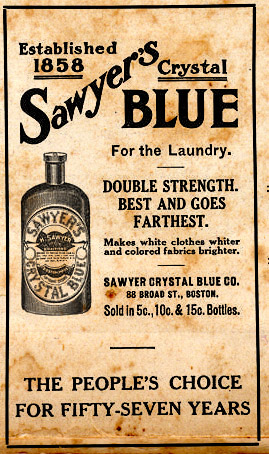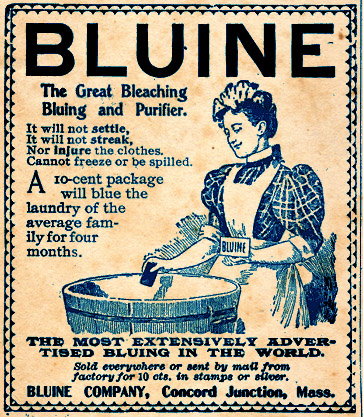If you open any cookbook or other domestic book for house keepers you will usually find instructions on how to do laundry. Inevitably you will come upon the rinsing of clothes to be done by putting into bluing. This is what was commonly used to brighten whites. In it’s earliest forms it was used by having indigo tied in a thin muslin bag and shaken in the water until the right shade was produced to brighten whites. But natural indigo was of a darker blue color and dull according to some. In addition it was costly to manufacturer so when other cheaper and brighter blues were made the indigo bluing fell out of general use.

By the early part of the twentieth century there were many kinds of bluing being used. Besides Indigo, there was ultramarine, Prussian blue, aniline blue, and then Indigo manufactured chemically. Some bluing was sold as liquid form and others were found in solid form.
Ultramarine blue originally came from the stone lapis lazuli, which was ground fine. Then it was manufactured chemically. It has a bright color and was commonly used in the home by the early 1900’s. In the marketplace this form could be found in little balls.
Prussian blue is from a chemical origin from iron as one of its bases. It is of a bright blue color and sold in liquid form, even found on the market today. One source claims that if the clothes are not thoroughly rinsed or if any of the blue was left in the clothes, the iron in its composition would unite with the alkali of the soap and iron rust spots would appear on the clothes. Many people, however, have had a lot of success with Mrs.Stewart’s bluing which is sold in many stores today.
Aniline blue was a strong dye and only a small quantity was required. It was sold in either solid or liquid form. In the early 1900s it was cheaper and more effective and gave a good clear color. It was used more by public laundries than housekeepers in general.
I’ve also seen Chinese blue mentioned in the making of bluing. Just a few companies that made bluing that I ran across were Pyle’s, Bluine, and Sawyer’s.
Now if you are looking to make your own bluing you can try the following recipe from 1866:
Take best Prussian-blue, pulverized, 1 oz.; Oxalic acid, also pulverized, 1/2 oz.; soft water 1 qt. Mix. The acid dissolves the blue and holds it evenly in the water, so that specking will never take place. One or two table-spoons of it is sufficient for a tub of water, according to the size of the tub.
And a variant of the above recipe from the 1880s:
One ounce soft Prussian blue, 1/4 ounce Oxalic acid, and 1 gallon soft water. One teaspoon is enough for a large wash.
Mrs. Stewart’s have similar ingredients to the above recipe, except that they have added a ph balancer. Their liquid form of bluing is highly concentrated so you only need about 1/4th a teaspoon which is put into a quart of water and stirred before adding to a full size load of wash. You can use their store locater to find where they are sold. I found it in my local Kroger’s.
And although we have Pearline’s humorous account for how Monday came to be called Blue Monday the more likely cause is Bluing.

